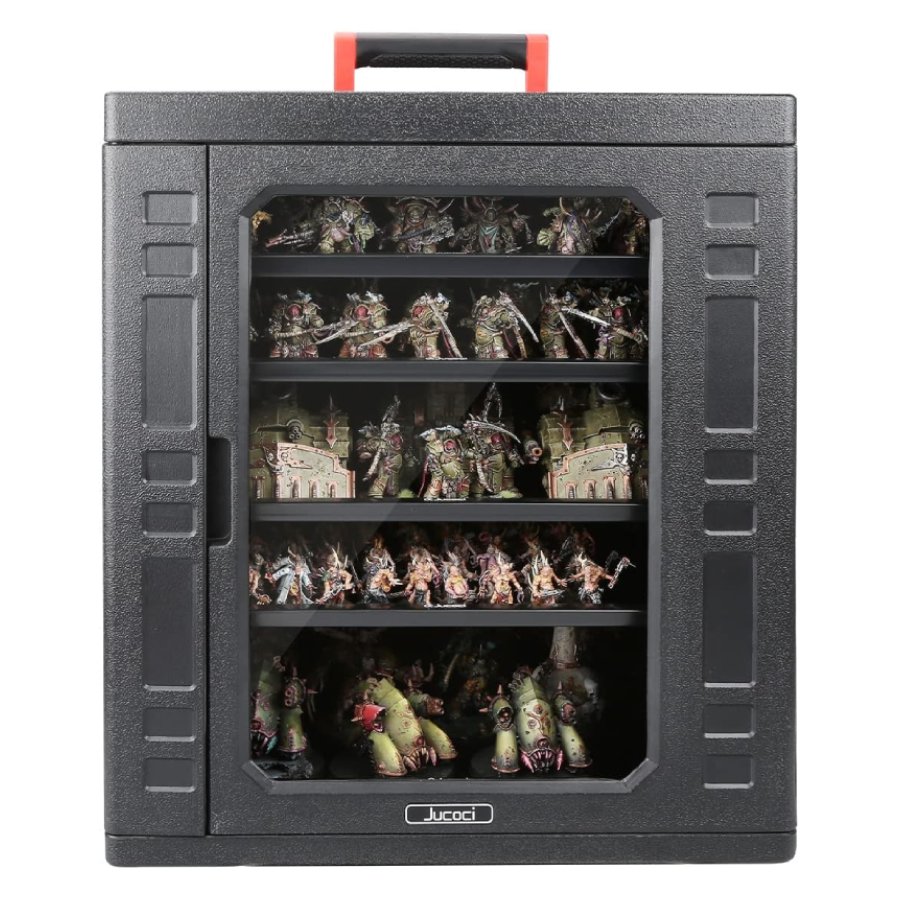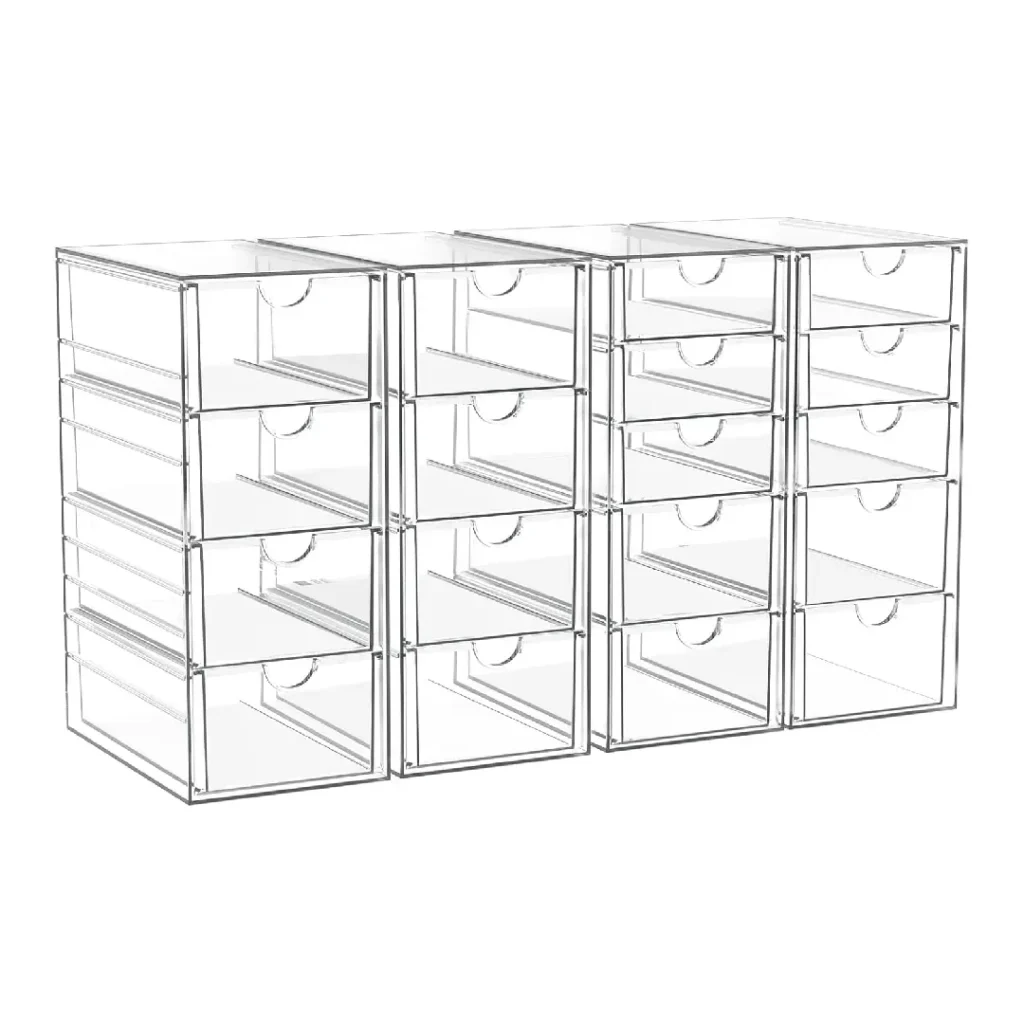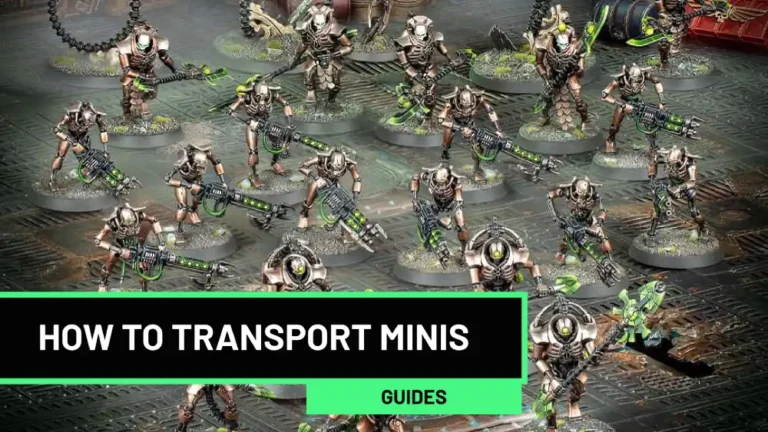In this Guide:
Preparing Your Models for Storage and Transport
Before we dive into storage and transportation solutions, let’s talk about some useful tips that can save you a lot of headaches down the line.
Tip No. 1: Before Packing, Check Your Models!
Before packing your miniatures for storage or transport, it’s crucial to take a few moments to thoroughly inspect each model, looking for any loose components or other damage.
Pay special attention to delicate parts like thin weapons, antennas, or spindly limbs, as these are most prone to breakage during transit.
If you find any issues, take the time to carefully repair them using appropriate glue or putty.
Remember, any part that’s not securely attached is likely to be the first casualty of a bumpy ride or rough handling, so a little extra care at this stage can save you a lot of heartache later on.
Tip No. 2: Magnetizing Models will Make Your Life Easier
One of the best ways to protect your models during transport is by magnetizing them for easy disassembly.
This technique is particularly useful for models with delicate or protruding parts that are prone to breakage, like the slender sword of an Eldar Wraithknight or the thin, fragile fins of a Tau Riptide.
To magnetize your models, you’ll need a pin vise (a small hand drill), drill bits, and the appropriate magnets for your minis’ parts. Start by carefully drilling small holes in the parts you want to magnetize, making sure not to damage any details.
The holes should be just wide enough and deep enough to snugly fit your magnets.
Next, glue a magnet into each hole, paying attention to the polarity. A good trick is to use a spare magnet to hold the pieces in place while the glue dries, ensuring the correct alignment.
Magnetizing your models does require a bit of extra work upfront, but it’s a worthwhile investment for any serious Warhammer 40K collector.
So, if you have models with particularly fragile or awkward bits, consider giving magnetization a try. With a little patience and practice, you’ll be able to disassemble and reassemble your models with ease, keeping them safe and sound no matter where your Warhammer 40K adventures take you.
Still unsure about this? Here’s a fun video that makes Magnetizing easy!
Tip No. 3: Labeling and Organizing Models
Labeling and organizing your models is a simple but essential step in efficient storage and transport. It may seem like a tedious task, but trust me, it will save you a ton of time and frustration in the long run.
Especially if you’re playing often outside your own house!
I like to use small stickers or tags to identify each unit. You can write the unit name, point value, or any other relevant information on these labels.
For example, I might label a squad of Space Marine Intercessors with “Intercessors – 100 pts” or a Necron Overlord with “Overlord – 100 pts, Resurrection Orb”
When applying labels, be sure to place them in a spot that’s easily visible but won’t detract from the appearance of your painted models.
I usually put them on the underside of the base, where they’re out of sight during gameplay but still easy to read when I’m rummaging through my storage bins.
Another helpful tip is to color-code your labels based on army, unit type, game type or battlefield role. For instance, you could use blue labels for your Space Marine infantry or the Space Marine Units used in Combat Patrol games, green for your vehicles, and red for your HQ units.
This makes it even easier to grab the models you need at a glance.
Transporting W40K Armies: Cases, Bags and Cheap, DYI Solutions
When it comes to transporting your Warhammer 40K models, there are several options to choose from, each with its own advantages. You’ll have to choose between hard cases, soft cases and bags, and, if you’re handy, DIY solutions.
Hard Cases:
These are absolutely great to have, as they can function as a permanent storage as well but, they’re big, bulky and you’ll probably need a car to move them around. No worries, there’s some that also come with wheels!

Hard cases are the gold standard for protecting your most valuable models. They’re made from rigid, durable materials like plastic or aluminum and often feature foam inserts custom-cut to fit specific models.
The foam keeps your miniatures securely in place, preventing them from shifting or colliding with each other during transport.
I personally use hard cases for my prized Primaris Space Marine characters and vehicles, like my Ghazghkull Thraka.
These models are not only expensive but also have a lot of intricate details and delicate parts that could easily be damaged if not properly protected.
Some popular hard case options include:
- Citadel Battle Figure Case – $164 on Amazon
- Citadel Skirmish Case – $59.50 on Amazon
- Battlefoam P.A.C.K. 720 – $205 on Amazon
- oTTRPGo Transport Display Storage Case – $159 on Amazon
These cases come in various sizes to accommodate different model types and army sizes and some of them, like the oTTRPGo one comes with wheels!
Soft Cases and Bags
Soft cases and bags are a more affordable and flexible option for transporting the bulk of your army. They’re typically made from lightweight, durable materials like nylon or polyester and feature padding or soft compartments to protect your models.
Over time I used a variety of soft cases and bags for my rank-and-file infantry, for smaller games such as Combat Patrol.
These models are less delicate than my characters and vehicles, so they don’t require the same level of protection. Plus, soft cases are easier to carry and store than bulky hard cases. Perfect for your weekly skirmish or Kill Team match.
I used a Feldherr Mini Plus but if you’re looking for more options, here they are:
- Gargoyle Miniatures Carrying Case – $39.99 on Amazon
- Madcat’s Minature Carrying Case with Foam Layer – $35.99
- ENHANCE Miniature Figure Satchel – $49.99
Many of these cases feature adjustable compartments or movable foam trays, allowing you to customize the layout to fit your army.
Cheap DYI Transport Solutions
As any Warhammer 40K enthusiast knows, safely transporting your carefully painted miniatures is crucial. While there are many commercial options available, DIY solutions can be both cost-effective and tailored to your specific needs.
Here are some creative ideas to keep your army safe on the move:
1. Magnetized Storage Boxes
Create a secure transport system by lining a plastic storage box with thin steel sheets. Glue small magnets to the bases of your miniatures, and they’ll stay put even if the box gets jostled. This method works great for infantry and smaller vehicles.
2. Foam-Lined Tackle Boxes
Fishing tackle boxes make excellent miniature cases with a bit of modification. Cut foam inserts to fit the compartments, creating snug spaces for your models. The adjustable dividers in many tackle boxes allow you to customize the layout for different unit sizes.
3. Egg Carton Infantry Carriers
For a budget-friendly option, save those cardboard egg cartons! They’re perfect for transporting infantry models. Line each cup with a small piece of foam for extra protection. While not suitable for larger models, this method is great for troops and can be easily stacked in a larger container.
There’s proof of that in the wild! 🙂
Comment
byu/Salt_Historian2844 from discussion
inkillteam
4. Custom Foam Trays
Create your own foam trays using craft foam sheets. Cut the foam to fit your storage container, then use a hot wire cutter or sharp knife to carve out spaces for your miniatures. This method allows you to create a perfect fit for even your most oddly-shaped models.
5. Toolbox Conversions
Many toolboxes come with removable trays and adjustable compartments, making them ideal for conversion into miniature cases. Line the compartments with foam and adjust the dividers to fit your army composition. The sturdy construction of toolboxes offers excellent protection during transport.
6. Magnetic Sheets for Vehicles
For larger vehicles, consider using magnetic sheets in a deep storage container. Place the magnetic sheet on the bottom of the container and attach small metal plates to the underside of your vehicle bases. This method keeps heavy models from shifting during transport.
Warhammer 40,000 Miniatures Storage Solutions
DIY Storage solutions
DIY storage solutions are a great way to keep your models organized and protected at home without breaking the bank. With a little creativity and some basic supplies, you can create custom storage that perfectly fits your collection.
One of my favorite DIY tricks is using a plastic office supply organizer for my smaller units or models i’m in the process of painting.

They’re stackable, so you can easily expand your storage as your army grows, and the clear plastic makes it easy to see what’s inside each drawer.
Another DIY option is to create your own foam trays using a material like pick-and-pluck foam. This type of foam has pre-cut cubes that you can easily remove to create custom-sized compartments for your models. You can then store these trays in a variety of containers, like plastic bins or even old suitcases.
The key to effective DIY storage is to find solutions that are both practical and affordable. Look for materials that are sturdy, easy to work with, and readily available.
And don’t be afraid to get creative – sometimes the best storage solutions are the ones you invent yourself!.
Storing and Transporting Large Warhammer 40K Models
If you’re like me and have an ever-growing collection of vehicles, lords of war, and huge centerpiece models, you know the challenge of storing and transporting larger miniatures.
Building Your Own Foam Inserts
For these big boys, creating custom foam inserts tailored to your specific models is ideal. Here’s how:
- Measure your model carefully, including any protruding parts.
- Cut foam sheets to size, leaving extra room for padding.
- Trace the outline of your model onto the foam.
- Carefully cut out the shape, creating a snug fit for your model.
- Create additional cutouts for removable parts like sponson weapons or turrets.
This method ensures a perfect fit and maximum protection for your prized models.
Using Plastic Containers with Custom Padding
Large plastic storage containers can be converted into excellent transport solutions for big models:
- Choose a container slightly larger than your model.
- Line the bottom with a thick layer of foam.
- Cut foam blocks to fit snugly around your model, preventing movement.
- Use softer foam or bubble wrap for any delicate parts.
This method offers flexibility and can be easily modified for different models.
Tips for Safe Transportation
To ensure your Warhammer 40K army arrives at its destination in pristine condition, consider these additional tips:
- Avoid Extreme Temperatures: Never leave your models in hot cars or direct sunlight. Extreme heat can warp plastic and melt glue.
- Handle with Care: Always use both hands when carrying your transport case, regardless of its size. This reduces the risk of dropping or jostling your models.
- Use Hand Trucks for Large Collections: If you’re transporting a large army, invest in a hand truck or dolly. Your back will thank you, and it reduces the risk of accidents caused by struggling with heavy loads.
- Organize by Weight: When packing multiple models, place heavier items at the bottom of your container and lighter, more delicate pieces on top.
- Label Everything: Clearly label your containers, especially if you’re using multiple cases. This helps you quickly find specific units and prevents accidentally opening the wrong case.
Remember, the key to any good transport solution is preventing your miniatures from bumping into each other or the sides of the container. With these DIY methods and safety tips, you can create a custom transport system that keeps your Warhammer 40K army safe, secure, and ready for battle!
So there you have it – my tips and tricks for how to store Warhammer 40000 models and how to transport Warhammer models. Experiment with different storage options to find what works best for your collection, and don’t be afraid to get creative with DIY solutions.
With a little care and preparation, you can ensure that your models will be ready to conquer the tabletop for years to come. Now if you’ll excuse me, I have a Space Marine 2 game to get to. For the Emperor!

